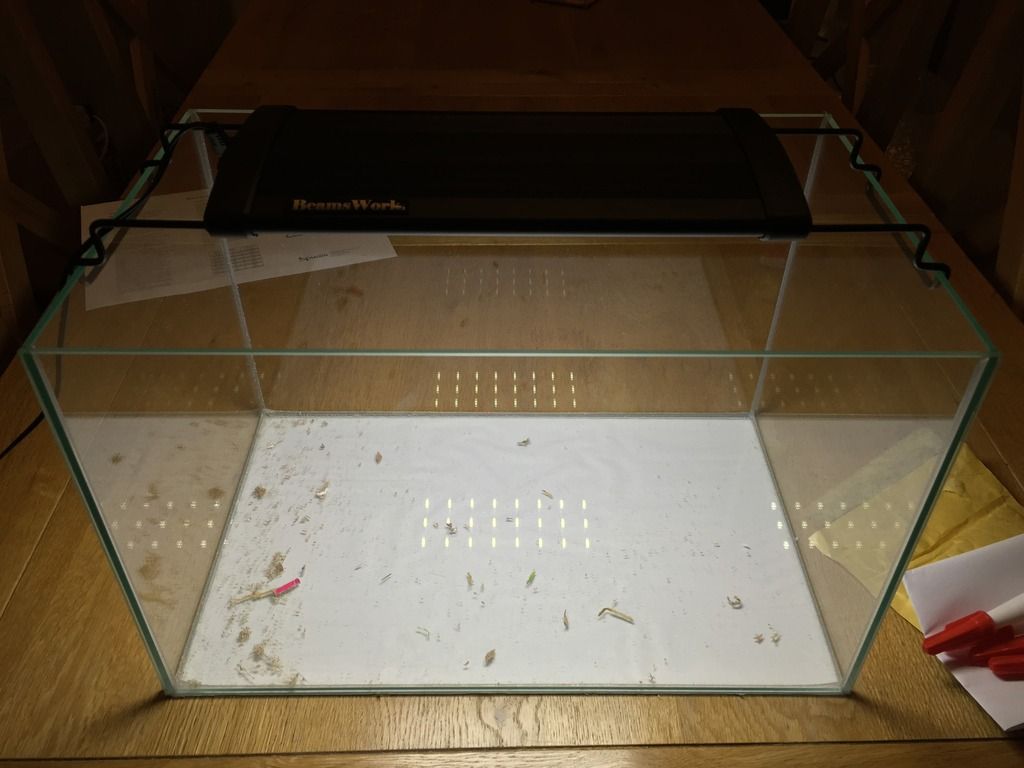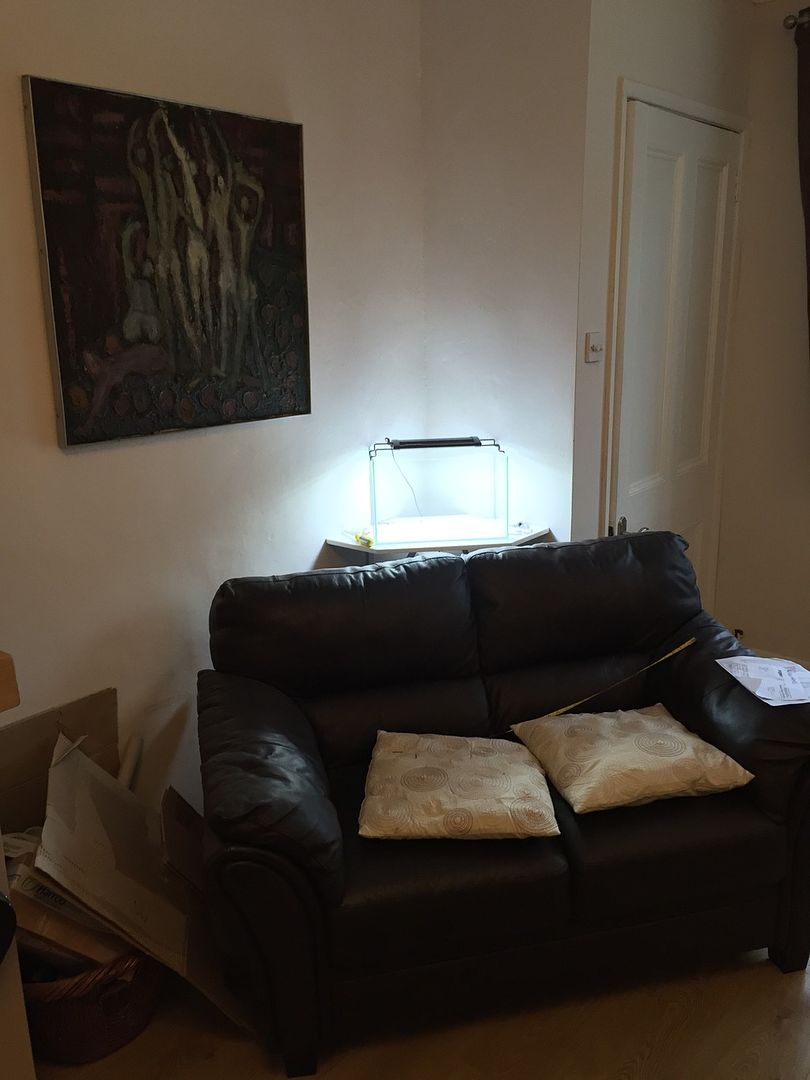My freshwater planted nano tank project
Discussion
I've been away from fish keeping for a good few years, and I miss it. (I also miss keeping rats, but that's much harder to swing with Mrs Oxgreen.) So I've decided to set up a nano tank as a winter project. Mrs Oxgreen likes the idea too, so it's all systems go!
For me, an aquarium is as much an underwater garden as it is a container for some fish. In fact, I tend towards the "Dutch" style, where plants dominate and fish are merely a minor point of interest. So my aim is a mini Dutch-style aquarium.
I've been thinking a lot about what setup I'm going to create, and have settled on the following choices (I think):
If anyone's interested I'll post up the occasional picture as the project progresses!
I can't wait to start getting geeky with aquarium kit!
Edited to add: My choices are not set in stone, so if you think I'm making a mistake or you have some other good ideas, I'm all ears...
For me, an aquarium is as much an underwater garden as it is a container for some fish. In fact, I tend towards the "Dutch" style, where plants dominate and fish are merely a minor point of interest. So my aim is a mini Dutch-style aquarium.
I've been thinking a lot about what setup I'm going to create, and have settled on the following choices (I think):
- Tank: 24 litre - 40x25x24cm. To my mind, anything much bigger than this isn't truly a "nano" tank. "Nano" means "tiny", not just small.
- Filtration: External canister filter, possibly a Fluval 106. Any type of internal filter takes up valuable space in a nano tank, and is always more awkward to maintain. An external filter also very slightly increases the overall body of water.
- Lighting: 1300 lumens of 6,500K LED. This is probably equivalent to between 20-25W of compact fluorescent, giving about 3-4 Watts per US gallon. I want to grow some of the most demanding plants, so I need lots of light.
- CO2 injection, probably from a soda stream canister, with a solenoid valve so that I can synchronise it to the lights. I've used fermentation before, and it works - but you can't control it and it needs renewing every 10 days or so.
- Heating: I'm going to go for an external inline filter, so that there's as little equipment inside the tank as possible. Unfortunately that means I'll have to go for a 200W power, which is far too big really - so I intend to get a separate temperature controller (STC-1000) so that if either sticks in the 'on' position the heating will still be regulated by the other thermostat.
- Plants: I want a nice carpet of something like Glossostigma and/or Hemianthus micranthemoides. These are often rated as difficult, but I've grown them before under strong light with fermented CO2 and that seems to be the key. I love seeing bubbles of oxygen forming on tiny leaves! I also like hair grass, small cryptocorynes and something red/brown for contrast.
- Fish: Probably half a dozen chilli rasboras. Mrs Oxgreen likes suckermouth catfish, so probably an otocinclus. A small handful of cherry shrimp type things, but maybe in a bright blue colour for contrast with the rasboras. That'll probably be plenty of livestock. Too much? What do you think? The oto will need feeding, because there hopefully won't be enough algae for it.
If anyone's interested I'll post up the occasional picture as the project progresses!
I can't wait to start getting geeky with aquarium kit!

Edited to add: My choices are not set in stone, so if you think I'm making a mistake or you have some other good ideas, I'm all ears...

Edited by Dr Mike Oxgreen on Sunday 18th October 19:20
^^ Wahey - that's what I'm talking about! I like that bronze crypt.
Failure with plants is usually down to insufficient light initially. The lids of most aquaria do not provide enough lighting for good plant growth, and for that reason I'm avoiding any of the all-in-one nano kits so that I can choose all the components myself. I suppose it's a bit like buying hifi separates rather than a ready-made system.
Plants generally suffer from "limiting factors". The first limiting factor is usually insufficient light, but if you provide lots of light then CO2 becomes limiting and you need to provide that as well. The third thing to become limiting is nutrients: in a tank with lush plant growth the nitrate level will drop towards zero and you need to add nutrients. I haven't decided on my fertilisation regime yet; I've read about "EI" where you slightly overdose with daily nutrients and then do a big water change each week, but that sounds like a lot of work!
It's worth noting that plants do not like under-gravel filtration, but that seems to have fallen out of fashion these days.
I am a bit concerned that my filter choice might be too powerful. I'd like to mount it below the tank, so that will reduce flow. What filtration are you using, otolith?
Edited to add: Now considering the Eheim Classic 2211, which has a flow of about 300 litres per hour. Still generous, but probably sensible.
Failure with plants is usually down to insufficient light initially. The lids of most aquaria do not provide enough lighting for good plant growth, and for that reason I'm avoiding any of the all-in-one nano kits so that I can choose all the components myself. I suppose it's a bit like buying hifi separates rather than a ready-made system.
Plants generally suffer from "limiting factors". The first limiting factor is usually insufficient light, but if you provide lots of light then CO2 becomes limiting and you need to provide that as well. The third thing to become limiting is nutrients: in a tank with lush plant growth the nitrate level will drop towards zero and you need to add nutrients. I haven't decided on my fertilisation regime yet; I've read about "EI" where you slightly overdose with daily nutrients and then do a big water change each week, but that sounds like a lot of work!
It's worth noting that plants do not like under-gravel filtration, but that seems to have fallen out of fashion these days.
I am a bit concerned that my filter choice might be too powerful. I'd like to mount it below the tank, so that will reduce flow. What filtration are you using, otolith?
Edited to add: Now considering the Eheim Classic 2211, which has a flow of about 300 litres per hour. Still generous, but probably sensible.
Edited by Dr Mike Oxgreen on Monday 19th October 07:24
The equipment is steadily arriving. So far I have:
They've actually sent me a different light unit. The one I ordered was going to be slightly too big and would need some ingenuity to make it sit correctly on top of the tank. The one they've sent me isn't listed, but is smaller and will fit properly, and only 100 lumens less powerful (1200 instead of 1300) - so actually it's a much better choice. It should still be a nice high light level in this small tank.
The tank itself appears to be coming from Germany - one of the quirks of Amazon's marketplace! I'm also waiting for the filter (I went for the Eheim 2211 in the end), a lily pipe and a pair of electronic timers (one for the lights, and another for the CO2).
The first job will be constructing some shelving in the corner of the room to hold the tank and the equipment. Probably a job for next weekend.
- The inline heater
- The CO2 kit, with bubble counter, diffuser, drop checker and soda stream canister
- The light
They've actually sent me a different light unit. The one I ordered was going to be slightly too big and would need some ingenuity to make it sit correctly on top of the tank. The one they've sent me isn't listed, but is smaller and will fit properly, and only 100 lumens less powerful (1200 instead of 1300) - so actually it's a much better choice. It should still be a nice high light level in this small tank.
The tank itself appears to be coming from Germany - one of the quirks of Amazon's marketplace! I'm also waiting for the filter (I went for the Eheim 2211 in the end), a lily pipe and a pair of electronic timers (one for the lights, and another for the CO2).
The first job will be constructing some shelving in the corner of the room to hold the tank and the equipment. Probably a job for next weekend.
AlexC1981 said:
With a tank as densely planted as Otolith's above, do you still have to clean the substrate? I give mine a gravel vacuum weekly when I do the water change and get quite a lot of poo out from between the gravel by raking the tube through it, which would be otherwise rotting?
In practice you can't really, because there's nowhere to put a gravel vacuum thingy without sucking up some of the plants. The fish stocking level will be very small though, so hopefully most waste will break down naturally.otolith said:
The hardest part is calibrating the CO2, because there is a lag between adjustments and output. Quite easy to fiddle with it and gas your fish.
Yes indeed. I plan to spend a while experimenting with the CO2 level before adding any fish or other animals. I want to see what sort of pH swing I get during the dark period when the CO2 switches off, and if necessary I might consider having a few CO2 'on' periods during the darkness to prevent the pH rising too much. I will also see what happens if I leave the CO2 on permanently during the darkness; hopefully it won't go dangerously high so that if the timer or solenoid fails it won't be a problem. I'm assuming that the rate of CO2 usage by the plants is much smaller than the rate at which CO2 is expelled at the water surface, and I'm also assuming that the fish won't contribute much to the CO2 level. It'll be interesting finding out!otolith said:
Technically, I should be doing a weekly 50% water change to keep the fertilisers at the right level, but in practice it manages with less attention than that.
So do you use "EI" fertilisation, where you slightly overdose with daily fertilisation and then (supposedly) do a weekly 50% water change to prevent the levels rising? I haven't decided on my fertilisation regime yet; I'm probably going to try a less intense routine and see how it goes. I don't think I can be arsed with fertilising every day and water changing every week.I hadn't thought about using an electronic pH meter, but now you've planted the seed in my mind, and I might end up spending even more money on this silly project. So, er, thanks!

After I've done this nano tank, I can see myself wanting to do a plants-only "pico" tank, probably using a florist's vase, with CO2 fermentation and no filtration.
ducgas said:
Might be worth having a look here. http://www.thegreenmachineonline.com/
Bloody hell - they've got fish tanks similar size to mine for about £1600 (and that's a sale price!). Admittedly they're join-free tanks and do sound rather fantastic, but blimey! 
I have now ordered a piece of 0.5mm, A3-sized Perspex from Amazon, out of which I will make a lid. Perhaps I'll silicone some kind of plastic runners to the inside ends of the tank so that I can make a two-piece sliding lid.
The cabinet is nearing completion. Quite pleased with the double-hinged doors, which fold back giving full access.
I've connected up the filter and the heater, and filled it up to test the equipment. I have had to buy a better inline heater - the cheap one I bought online was crap and the hose connections were simply not watertight. The Hydor one I've now bought was a lot more expensive but seems very good.
I will obviously cut the hoses to more sensible sizes to get rid of the coils of excess hose. And I'll mount the heater and the socket strip on the wall as well.
The water is a little green, because I used rainwater from the water butt. Hopefully any single-celled algae will be out-competed once there are plants in the equation.
I did connect up the CO2 kit, but I think I must have had a leak because the cylinder emptied itself after only a week or so. I've got a refill, and will play with that once I've tidied up the plumbing.
Slightly surprised that the heater is cycling on and off so rapidly. It is on for about 30 seconds, then off for about 2 minutes. By my reckoning, that's a total of 40W - which surprises me. Also, the heater must be incredibly sensitive - by my calculations, a 200W heater operating for 30 seconds on a 25 litre tank would raise the temperature by about 0.06 degrees, which appears to be enough for the heater to decide to switch off again. It is certainly holding a very tight temperature.
I saw some Phoenix rasboras in the shop yesterday, and they are now a strong contender for a little shoal of fish. Quite similar to the Chili rasboras that I'm also considering, but maybe even smaller. I'm now thinking about having more than one Otocinclus because a single specimen might not be happy on its own - if I can keep them fed then do you think two will be okay in a tank 40x25x25 (25 litres)? I'll be having some little shrimps as well - possibly these blue ones.
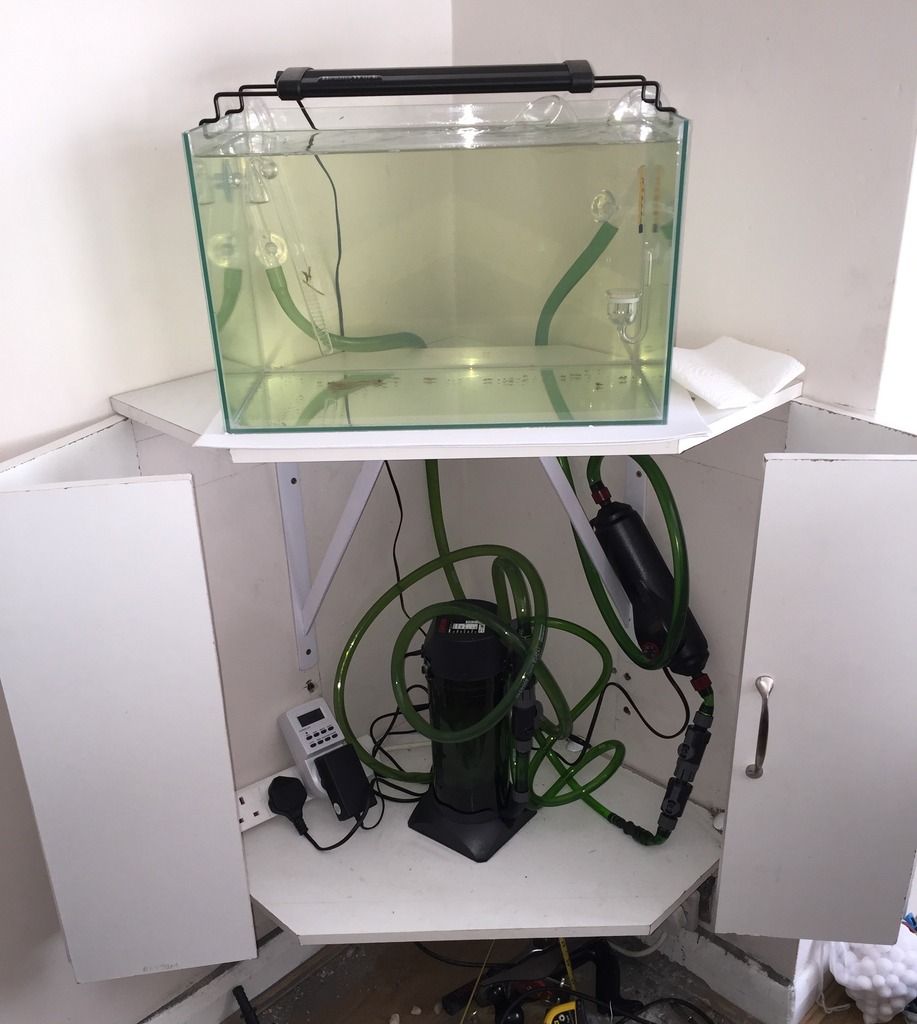
Edited to add: At the moment, the lily pipe is pointing in the wrong direction and the water is possibly reaching the outflow siphon tube before mixing properly. This might mean that the heater is sensing its own output heat almost as soon as it switches on. Perhaps once I've got the plumbing sorted out properly and the lily pipe is pointing where I want it, then the heater might not cycle quite so rapidly.
I've connected up the filter and the heater, and filled it up to test the equipment. I have had to buy a better inline heater - the cheap one I bought online was crap and the hose connections were simply not watertight. The Hydor one I've now bought was a lot more expensive but seems very good.
I will obviously cut the hoses to more sensible sizes to get rid of the coils of excess hose. And I'll mount the heater and the socket strip on the wall as well.
The water is a little green, because I used rainwater from the water butt. Hopefully any single-celled algae will be out-competed once there are plants in the equation.
I did connect up the CO2 kit, but I think I must have had a leak because the cylinder emptied itself after only a week or so. I've got a refill, and will play with that once I've tidied up the plumbing.
Slightly surprised that the heater is cycling on and off so rapidly. It is on for about 30 seconds, then off for about 2 minutes. By my reckoning, that's a total of 40W - which surprises me. Also, the heater must be incredibly sensitive - by my calculations, a 200W heater operating for 30 seconds on a 25 litre tank would raise the temperature by about 0.06 degrees, which appears to be enough for the heater to decide to switch off again. It is certainly holding a very tight temperature.
I saw some Phoenix rasboras in the shop yesterday, and they are now a strong contender for a little shoal of fish. Quite similar to the Chili rasboras that I'm also considering, but maybe even smaller. I'm now thinking about having more than one Otocinclus because a single specimen might not be happy on its own - if I can keep them fed then do you think two will be okay in a tank 40x25x25 (25 litres)? I'll be having some little shrimps as well - possibly these blue ones.

Edited to add: At the moment, the lily pipe is pointing in the wrong direction and the water is possibly reaching the outflow siphon tube before mixing properly. This might mean that the heater is sensing its own output heat almost as soon as it switches on. Perhaps once I've got the plumbing sorted out properly and the lily pipe is pointing where I want it, then the heater might not cycle quite so rapidly.
Edited by Dr Mike Oxgreen on Thursday 12th November 11:15
otolith said:
I am wondering slightly whether the rain water was a good idea - you've probably introduced a lot of algal species you wouldn't have got in tap water.
Yes, I might not stick with the rainwater. I might use a mixture of tapwater and shop-bought R/O water instead. Hopefully I can get the plants growing well enough to squeeze out any algae.Bit of an update, although not a hugely exciting one.
It certainly is turning into a slow-burn project, made all the slower by the discovery of a faulty CO2 regulator; it took me a while to figure out that it wasn't me being a fool. I will be sending it back, and will have to wait for a replacement.
The filter and inline heater are all plumbed in and have been running nicely for a couple of weeks or more. The greenness of the water has reduced considerably. I've done some measurements, and will want to use a ratio of about one part tapwater to three parts rainwater, giving a KH of about 4 degrees and a similar GH.
This weekend, time permitting, I plan to drain down and do a couple of jobs that require the tank to be dry and moveable. Firstly, I want to spray the outside of the back glass. I'm going to use black 'Plastidip', which I'm hoping will give a nice textureless finish that you won't be aware of. And it'll be peelable if I change my mind.
Secondly, I want to make a support for a lid. Some kind of transparent plastic runners or something like that, then I'll have a two-piece lid that can slide back. I might drill lots of holes in the lid so that there is reasonable gas exchange.
I will also tip the bag of aquarium soil into the bottom and decide whether I've got enough. I've gone for a very fine sand-like soil with grains about a millimetre or two, which should enhance the sense of scale. Then I'll refill and wait for my regulator to come back so that I can start experimenting with the CO2.
I am planning to hand in my notice at work this afternoon and will probably take a sabbatical of a few months to decide what I want to do next in life - fed up with software development. So the tank might get a bit more attention - really hoping they offer gardening leave instead of making me work out my notice, but I think that's optimistic.
Edited to add: Pondering a Raspberry Pi Zero as a programmable temperature controller. Could then let the temperature drop a degree or two at night. But then, I did say I was fed up with software development...
It certainly is turning into a slow-burn project, made all the slower by the discovery of a faulty CO2 regulator; it took me a while to figure out that it wasn't me being a fool. I will be sending it back, and will have to wait for a replacement.
The filter and inline heater are all plumbed in and have been running nicely for a couple of weeks or more. The greenness of the water has reduced considerably. I've done some measurements, and will want to use a ratio of about one part tapwater to three parts rainwater, giving a KH of about 4 degrees and a similar GH.
This weekend, time permitting, I plan to drain down and do a couple of jobs that require the tank to be dry and moveable. Firstly, I want to spray the outside of the back glass. I'm going to use black 'Plastidip', which I'm hoping will give a nice textureless finish that you won't be aware of. And it'll be peelable if I change my mind.
Secondly, I want to make a support for a lid. Some kind of transparent plastic runners or something like that, then I'll have a two-piece lid that can slide back. I might drill lots of holes in the lid so that there is reasonable gas exchange.
I will also tip the bag of aquarium soil into the bottom and decide whether I've got enough. I've gone for a very fine sand-like soil with grains about a millimetre or two, which should enhance the sense of scale. Then I'll refill and wait for my regulator to come back so that I can start experimenting with the CO2.
I am planning to hand in my notice at work this afternoon and will probably take a sabbatical of a few months to decide what I want to do next in life - fed up with software development. So the tank might get a bit more attention - really hoping they offer gardening leave instead of making me work out my notice, but I think that's optimistic.
Edited to add: Pondering a Raspberry Pi Zero as a programmable temperature controller. Could then let the temperature drop a degree or two at night. But then, I did say I was fed up with software development...

Edited by Dr Mike Oxgreen on Thursday 26th November 13:54
A slightly more interesting update...
I have painted the back glass, added the substrate, bought a nice piece of dead wood, and refilled. It's looking a bit bubbly at the moment, and it all looks a bit black, but I've made some progress. I've even finished the cabinet, the shonkiness of which will mostly be hidden behind a sofa.
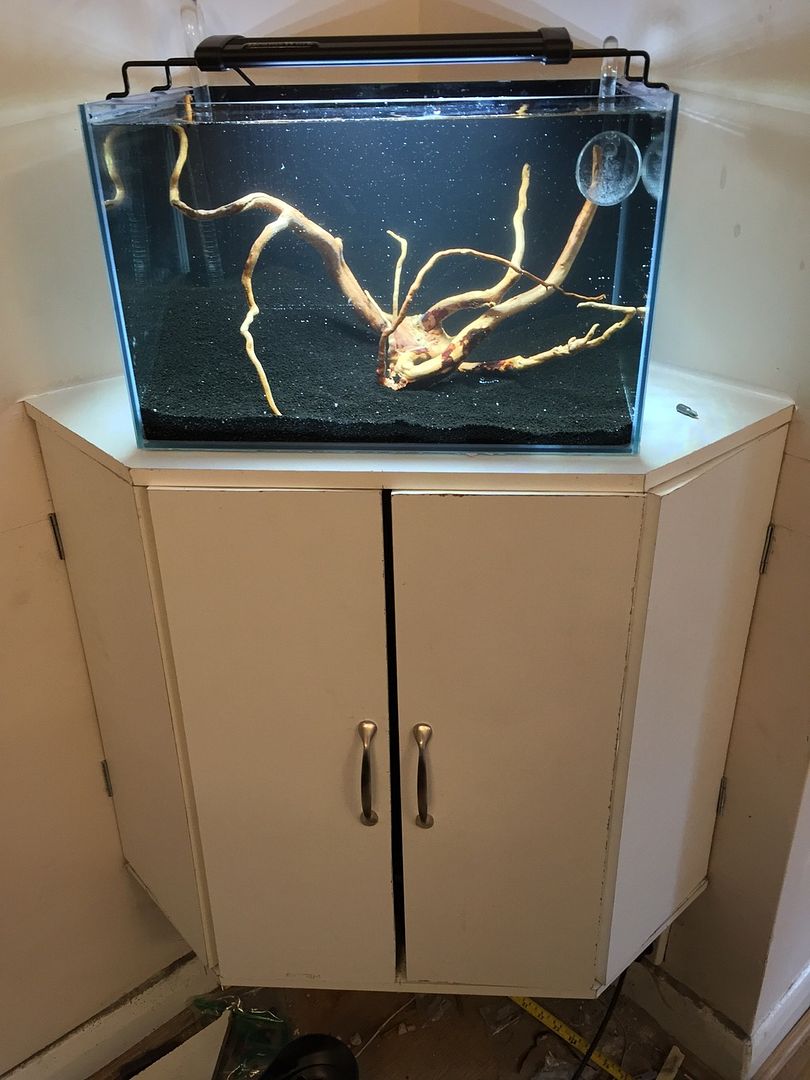
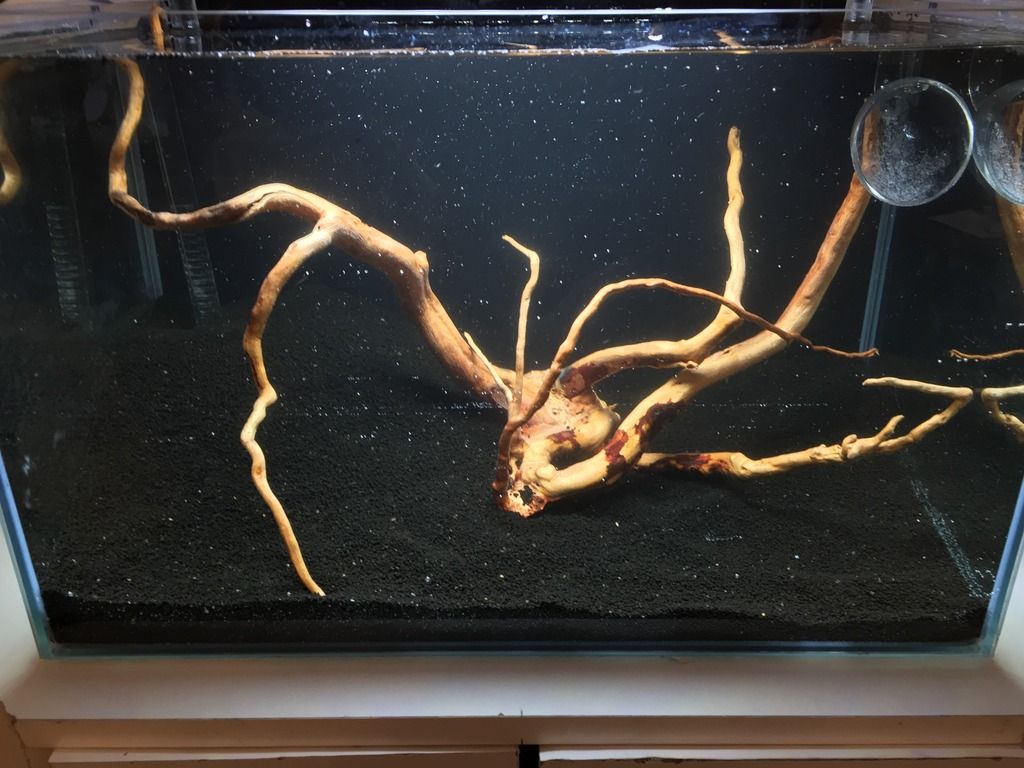
I have painted the back glass, added the substrate, bought a nice piece of dead wood, and refilled. It's looking a bit bubbly at the moment, and it all looks a bit black, but I've made some progress. I've even finished the cabinet, the shonkiness of which will mostly be hidden behind a sofa.


Edited by Dr Mike Oxgreen on Sunday 29th November 14:12
Yes, the Plastidip was easy, but it runs badly so I'd recommend spraying onto a horizontal surface. The instructions imply that you should use moderately heavy coats.
Time will tell whether it's tough enough. I accidentally damaged the paintwork when something dug into it, so I had to cut a section out with a knife and repaint. But that was when the paint had only just become touch-dry so it might be better now it's had some time to set properly.
Also, suction cups don't stick to it, even if you moisten them.
So it's quite good, but not without its drawbacks!
Can't wait to get the faulty regulator back so I can start experimenting with the CO2, then order my plants. The water has gone quite brown overnight, but that's to be expected and the instructions with the substrate do recommend changing the water frequently to start with.
Time will tell whether it's tough enough. I accidentally damaged the paintwork when something dug into it, so I had to cut a section out with a knife and repaint. But that was when the paint had only just become touch-dry so it might be better now it's had some time to set properly.
Also, suction cups don't stick to it, even if you moisten them.
So it's quite good, but not without its drawbacks!
Can't wait to get the faulty regulator back so I can start experimenting with the CO2, then order my plants. The water has gone quite brown overnight, but that's to be expected and the instructions with the substrate do recommend changing the water frequently to start with.
Tested the water last night.
Nitrite is way high: 5 mg/l
Nitrate is very high: 80 mg/l
Ammonia is zero.
Curious. So either:
I added about an eggcupful of my 'special' ammonium solution (see threads passim for details, or just use your imagination). Will test for ammonia this evening to see what's going on. If I can't get the ammonia level to go up then I guess my filter is already partly cycled, and I just need to wait for the population of nitrobacter to increase so that they keep the nitrite down to zero as well.
Nitrite is way high: 5 mg/l
Nitrate is very high: 80 mg/l
Ammonia is zero.
Curious. So either:
- the substrate has leached a load of nitrite and nitrate into the water, but no ammonia, or
- the substrate has leached some ammonia into the water, but my filter has already partially cycled and has already converted the ammonia into nitrite and thence into nitrate as well.
I added about an eggcupful of my 'special' ammonium solution (see threads passim for details, or just use your imagination). Will test for ammonia this evening to see what's going on. If I can't get the ammonia level to go up then I guess my filter is already partly cycled, and I just need to wait for the population of nitrobacter to increase so that they keep the nitrite down to zero as well.
Not bad growth, Galsia. I would be tempted to put lots more plants in, which will tilt the balance of competition towards the 'proper' plants and away from the algae. If you're worried about your light levels, try plants like Java Fern, Java Moss, and Anubias nana.
It would also be worth testing your water to see what your nitrate level is - it could be that you've got high-ish nitrates which are driving the algal growth. Again, more plants will help to reduce nitrate build-up, and of course water changes (but test your tapwater as well, sometimes it's surprisingly high in nitrate). You can get very simple test kits that consist of little strips that you dip in the water, and can give you several different test readings in one go - e.g. pH, nitrate, nitrite, KH, etc.
Low CO2 levels can also be the cause of algal growth. You can get liquid additives that will do a partial job of restoring the CO2 balance - that might be worth considering. Or try making a DIY yeast fermentation reactor out of a small plastic drink bottle and some tubing. There's plenty of guidance online.
My own tank is making biological progress. Last night I tested the water, and the ammonia has fallen from about 6 mg/l to about 3, and the nitrite has shot up and is now off the scale of my test strips. So the first stage of nitrification is definitely happening, which is good news.
Interestingly, the KH has dropped almost to zero and the pH has fallen from about 7.0 to about 6.5. So something (substrate?) has been acidifying the water and using up its KH buffering. I will need to keep an eye on this, and maybe do a big water change to restore the buffering and prevent a pH crash. To be fair, the instructions with the substrate do say that it's necessary to do frequent water changes at first, but I haven't bothered because there's no livestock in there and I'm more interested in getting the tank cycled. Before adding any fish (which is still at least a month or two away) I will probably buy a more accurate titration-based KH test.
The water surface has a persistent scum, and there is a bacterial film growing on the decorative wood. I'm hoping that these will disappear once everything is cycled and I've got plants growing, or indeed the shrimp will probably clean the wood up once they're introduced. For now I'm mopping up the surface scum with kitchen paper every day or two. I'm quite surprised that there's no algae, given that I have been switching the light on for a few hours each evening.
Still waiting for my repaired CO2 regulator to be returned to me, so I still haven't got any CO2 going in at the moment. I need that before adding plants. Glad that I'm happy for this to be a slow-developing project, otherwise I'd be getting frustrated!
It would also be worth testing your water to see what your nitrate level is - it could be that you've got high-ish nitrates which are driving the algal growth. Again, more plants will help to reduce nitrate build-up, and of course water changes (but test your tapwater as well, sometimes it's surprisingly high in nitrate). You can get very simple test kits that consist of little strips that you dip in the water, and can give you several different test readings in one go - e.g. pH, nitrate, nitrite, KH, etc.
Low CO2 levels can also be the cause of algal growth. You can get liquid additives that will do a partial job of restoring the CO2 balance - that might be worth considering. Or try making a DIY yeast fermentation reactor out of a small plastic drink bottle and some tubing. There's plenty of guidance online.
My own tank is making biological progress. Last night I tested the water, and the ammonia has fallen from about 6 mg/l to about 3, and the nitrite has shot up and is now off the scale of my test strips. So the first stage of nitrification is definitely happening, which is good news.
Interestingly, the KH has dropped almost to zero and the pH has fallen from about 7.0 to about 6.5. So something (substrate?) has been acidifying the water and using up its KH buffering. I will need to keep an eye on this, and maybe do a big water change to restore the buffering and prevent a pH crash. To be fair, the instructions with the substrate do say that it's necessary to do frequent water changes at first, but I haven't bothered because there's no livestock in there and I'm more interested in getting the tank cycled. Before adding any fish (which is still at least a month or two away) I will probably buy a more accurate titration-based KH test.
The water surface has a persistent scum, and there is a bacterial film growing on the decorative wood. I'm hoping that these will disappear once everything is cycled and I've got plants growing, or indeed the shrimp will probably clean the wood up once they're introduced. For now I'm mopping up the surface scum with kitchen paper every day or two. I'm quite surprised that there's no algae, given that I have been switching the light on for a few hours each evening.
Still waiting for my repaired CO2 regulator to be returned to me, so I still haven't got any CO2 going in at the moment. I need that before adding plants. Glad that I'm happy for this to be a slow-developing project, otherwise I'd be getting frustrated!
otolith said:
RE the pH instability, is it still filled with rainwater?
Not pure rainwater, no. After some experimentation I found that a ratio of 1 part tapwater to 3 parts rainwater gave me a KH and GH of about 4 degrees each, which is about what I want (or do you think that's too low?). After adding the substrate I therefore filled it with that ratio, and the KH was indeed around 4 degrees - but it has fallen since then. I haven't got a problem with low pH yet, but with a KH that barely registers on my test strips it's a potential issue.I think it's likely the substrate is leaching humic acid or something like that, which has gradually used up the KH buffering. It'll probably stop doing that after a few water changes.
After I've tested this evening, I might do a 50% water change with a 'stronger' ratio (more tapwater) to restore the KH to a more sensible level. I want to avoid a pH crash because I guess that would set back the development of my bacterial colony.
My plants have arrived! Just dunked them into the tank for now; proper planting will take place at the weekend.
I've also ditched the CO2 diffuser that made the tank look like a chemistry set and replaced with an inline diffuser out of sight, which seems to dissolve the CO2 far more effectively. There is just the faintest mist of bubbles, barely visible.
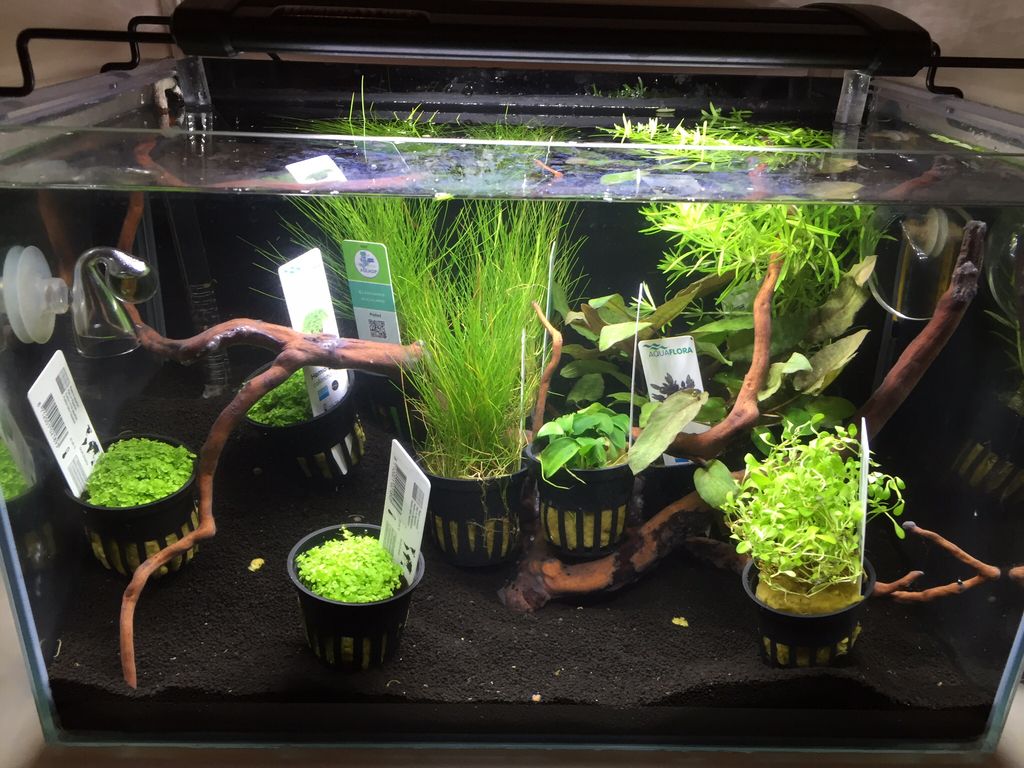
The plants are:
I might also pull some sprigs of hornwort out of my pond, because I love how that plant looks and I think it grows just as well at tropical temperature.
I've also ditched the CO2 diffuser that made the tank look like a chemistry set and replaced with an inline diffuser out of sight, which seems to dissolve the CO2 far more effectively. There is just the faintest mist of bubbles, barely visible.

The plants are:
- Three pots of Hemianthus callitrichoides 'Cuba', which I will split and will hopefully form a foreground carpet over the raised area of substrate on the left-hand side.
- Two pots of Eliocharis acicularis ("hair grass"), which I will split to form a background. I love this plant, which apparently is a UK native, and I have it in my pond - it survives being frozen, but it should also do well at tropical temperature. What a trooper of a plant!
- One pot of Eliocharis parvula, slightly shorter, to give depth to the hair-grass.
- A pot of Glossostigma, to form a contrasting foreground carpet on the right-hand side of the tank.
- A pot of Pogostemum erectus, for a bright green background plant to contrast against...
- ... a Cryptocoryne wendtii 'brown' for some colour contrast.
- An Anubias nana 'mini', which I will attach to the piece of wood, possibly with silicone.
I might also pull some sprigs of hornwort out of my pond, because I love how that plant looks and I think it grows just as well at tropical temperature.
Edited by Dr Mike Oxgreen on Thursday 17th December 21:03
Edited by Dr Mike Oxgreen on Friday 18th December 10:47
Gassing Station | All Creatures Great & Small | Top of Page | What's New | My Stuff




